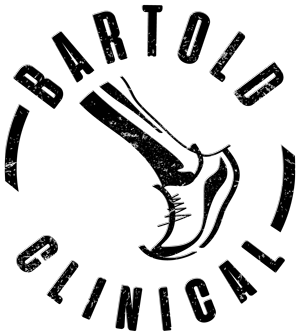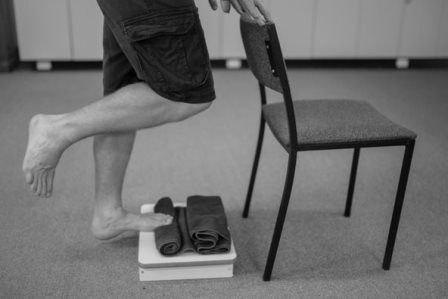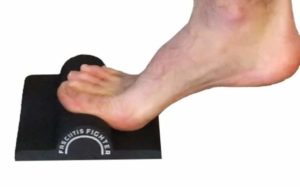
I have long suspected, given the similarities between tendinopathy and plantar fasciitis, that exercise may play a key role in the resolution of this pesky problem. A new study appears to support this…
[image:1]
High-load strength training improves outcome in patients with plantar fasciitis: A randomized controlled trial with 12-month follow-up. Rathleff et al Scandinavian Journal of Medicine & Science in Sports published online
Abstract:
The aim of this study was to investigate the effectiveness of shoe inserts and plantar fascia-specific stretching vs shoe inserts and high-load strength training in patients with plantar fasciitis. Forty-eight patients with ultrasonography-verified plantar fasciitis were randomized to shoe inserts and daily plantar-specific stretching (the stretch group) or shoe inserts and high-load progressive strength training (the strength group) performed every second day. High-load strength training consisted of unilateral heel raises with a towel inserted under the toes. Primary outcome was the foot function index (FFI) at 3 months. Additional follow-ups were performed at 1, 6, and 12 months. At the primary endpoint, at 3 months, the strength group had a FFI that was 29 points lower [95% confidence interval (CI): 6–52, P = 0.016] compared with the stretch group. At 1, 6, and 12 months, there were no differences between groups (P > 0.34). At 12 months, the FFI was 22 points (95% CI: 9–36) in the strength group and 16 points (95% CI: 0–32) in the stretch group. There were no differences in any of the secondary outcomes. A simple progressive exercise protocol, performed every second day, resulted in superior self-reported outcome after 3 months compared with plantar-specific stretching. High-load strength training may aid in a quicker reduction in pain and improvements in function
For an excellent commentary on this paper written by the author Michael Rathleff, go to Tom Goom’s excellent blog.

Perform one-legged heel raises on a stair with a towel inserted under the toes to elevate the toes (Figure 1). The towel should be thick enough that your toes are bent up as far as they will go at the top of the heel raise. Rather than a towel you can also use the Fasciitis Fighter device shown below.

This useful device helps to maintain a consistent 1st MPJ angle during the exercise
The final comment by Michael is measured and sensible:
“The loading paradigm for treatment of plantar fasciitis is by no means a miracle treatment.
However, it does provide us with the first evidence that high-load strength training may be the road towards more effective treatments for plantar fasciitis.
The key message to the patients is that they need to perform the exercises (otherwise they are unlikely to work) and they need to be performed slowly (3s up, 2s pause at the top and 3s down) to decrease risk of symptom flaring and with enough load starting by 12RM for three sets and working their way down to 8RM for five sets.”
and this certainly is something I will be incorporating into my treatment plan.
One response to “Exercise for Plantar Heel Pain Management”
Leave a Reply
You must be logged in to post a comment.



Simon – is this a new paper or the original?